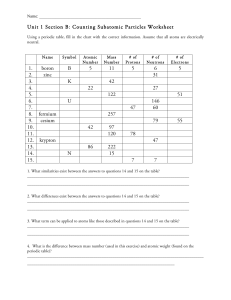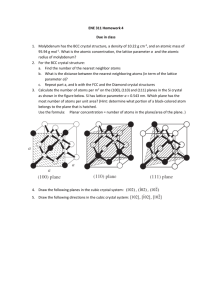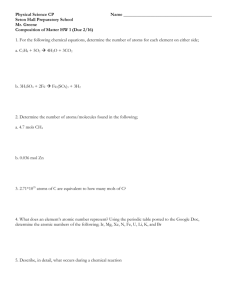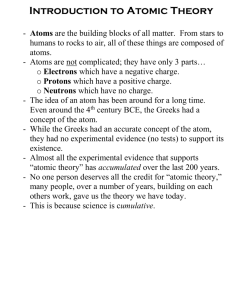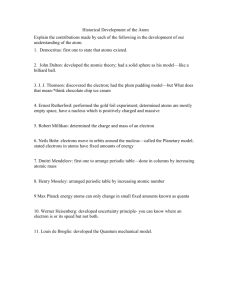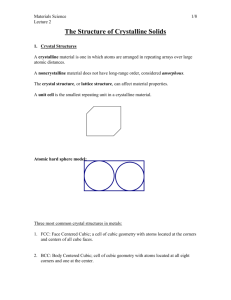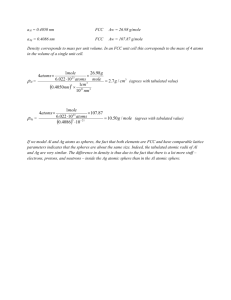CHAPTER 3: CRYSTAL STRUCTURES & PROPERTIES
advertisement
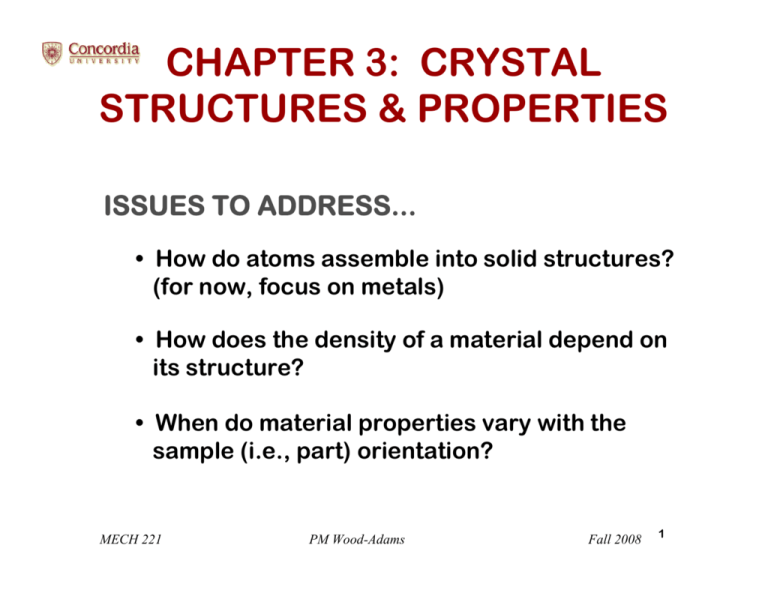
CHAPTER 3: CRYSTAL STRUCTURES & PROPERTIES ISSUES TO ADDRESS... • How do atoms assemble into solid structures? (for now, focus on metals) • How does the density of a material depend on its structure? • When do material properties vary with the sample (i.e., part) orientation? MECH 221 PM Wood-Adams Fall 2008 1 Crystal Structure • Motivation: Many of the properties of materials (especially mechanical) are determined by the arrangement of the atoms. This arrangement is called the material’s crystal structure. • An important distinction… – Atomic structure relates to the number of protons and neutrons in the nucleus of an atom, as well as the number and probability distributions of the electrons. – Crystal structure pertains to the arrangement of atoms in the crystalline solid material. MECH 221 PM Wood-Adams Fall 2008 • Atoms can be arranged either in a regular, periodic array (i.e., long-range order) or completely disordered (amorphous). • We need a way to specify crystallographic directions and planes. c To illustrate the concept of crystal structure and lattice systems, we first identify a coordinate system (x, y, z): z x y b a We can’t specify directions or planes without knowing what the reference system is. MECH 221 PM Wood-Adams Fall 2008 What is the Unit Cell? • The unit cell is the smallest group of atoms which can generate the entire crystal by translation. Definition: the length of each unit cell axis is called a lattice parameter. – In cubic systems, all three orthogonal lattice parameters are equal • Lattice parameters are typically on the order of a few Angstroms (or a few tenths of a nanometer) MECH 221 PM Wood-Adams Fall 2008 ENERGY AND PACKING • Non dense, random packing Energy typical neighbor bond length typical neighbor bond energy • Dense, regular packing r Energy typical neighbor bond length r typical neighbor bond energy Dense, regular-packed structures tend to have lower energy. MECH 221 PM Wood-Adams Fall 2008 2 MATERIALS AND PACKING Crystalline materials... • atoms pack in periodic, 3D arrays • typical of: -metals -many ceramics -some polymers crystalline SiO2 Adapted from Fig. 3.18(a), Callister 6e. Noncrystalline materials... • atoms have no periodic packing • occurs for: -complex structures -rapid cooling "Amorphous" = Noncrystalline Si Oxygen noncrystalline SiO2 Adapted from Fig. 3.18(b), Callister 6e. MECH 221 PM Wood-Adams Fall 2008 3 METALLIC CRYSTALS • tend to be densely packed. • have several reasons for dense packing: -Typically, only one element is present, so all atomic radii are the same. -Metallic bonding is not directional. -Nearest neighbor distances tend to be small in order to lower bond energy. • have the simplest crystal structures. We will look at three such structures... MECH 221 PM Wood-Adams Fall 2008 4 SIMPLE CUBIC STRUCTURE (SC) • Rare due to poor packing (only Po has this structure) • Close-packed directions are cube edges. In terms of the hard sphere model we say the atoms are touching in the close-packed directions! • Coordination # = 6 (# nearest neighbors) (Courtesy P.M. Anderson) MECH 221 PM Wood-Adams Fall 2008 5 ATOMIC PACKING FACTOR APF = Volume of atoms in unit cell* Volume of unit cell *assume hard spheres • APF for a simple cubic structure = 0.52 atoms unit cell a R=0.5a APF = close-packed directions contains 8 x 1/8 = 1 atom/unit cell volume atom 4 π (0.5a)3 1 3 a3 volume unit cell Adapted from Fig. 3.19, Callister 6e. MECH 221 PM Wood-Adams Fall 2008 6 BODY CENTERED CUBIC STRUCTURE (BCC) • Close packed directions are cube diagonals. --Note: All atoms are identical; the center atom is shaded differently only for ease of viewing. • Coordination # = 8 Adapted from Fig. 3.2, Callister 6e. (Courtesy P.M. Anderson) MECH 221 PM Wood-Adams Fall 2008 ATOMIC PACKING FACTOR: BCC • APF for a body-centered cubic structure = 0.68 Close-packed directions: length = 4R = 3a R Adapted from Fig. 3.2, Callister 6e. MECH 221 Unit cell contains: 1 + 8 x 1/8 = 2 atoms/unit cell a atoms volume 4 3 π ( 3a/4) 2 unit cell atom 3 APF = volume 3 a unit cell PM Wood-Adams Fall 2008 8 FACE CENTERED CUBIC STRUCTURE (FCC) • Close packed directions are face diagonals. --Note: All atoms are identical; the face-centered atoms are shaded differently only for ease of viewing. • Coordination # = 12 Adapted from Fig. 3.1(a), Callister 6e. (Courtesy P.M. Anderson) MECH 221 PM Wood-Adams Fall 2008 9 ATOMIC PACKING FACTOR: FCC • APF for a body-centered cubic structure = 0.74 Adapted from Fig. 3.1(a), Callister 6e. a MECH 221 PM Wood-Adams Fall 2008 10 FCC STACKING SEQUENCE • ABCABC... Stacking Sequence • 2D Projection A B B C A B B B A sites C C B sites B B C sites • FCC Unit Cell MECH 221 A B C PM Wood-Adams close-packed plane of atoms Fall 2008 11 HEXAGONAL CLOSE-PACKED STRUCTURE (HCP) • ABAB... Stacking Sequence • 3D Projection • 2D Projection A sites Top layer B sites Middle layer A sites Bottom layer Adapted from Fig. 3.3, Callister 6e. • Coordination # = 12 • APF = 0.74 MECH 221 PM Wood-Adams Fall 2008 12 THEORETICAL DENSITY, ρ # atoms/unit cell ρ= nA VcNA Volume/unit cell Atomic weight (g/mol) (cm3/unit cell) Avogadro's number (6.023 x 10 23 atoms/mol) Example: Copper Data from Table inside front cover of Callister (see next slide): • crystal structure = FCC: 4 atoms/unit cell • atomic weight = 63.55 g/mol (1 amu = 1 g/mol) • atomic radius R = 0.128 nm (1 nm = 10-7cm) Vc = a3 ; For FCC, a = 4R/ 2 ; Vc = 4.75 x 10-23cm3 Result: theoretical ρCu = 8.89 g/cm3 Compare to actual: ρCu = 8.94 g/cm3 MECH 221 PM Wood-Adams Fall 2008 14 Characteristics of Selected Elements at 20°C At. Weight Symbol (amu) Element Aluminum Al 26.98 Ar Argon 39.95 Ba Barium 137.33 Be Beryllium 9.012 B Boron 10.81 Br Bromine 79.90 Cd Cadmium 112.41 Ca Calcium 40.08 C Carbon 12.011 Cs Cesium 132.91 Cl Chlorine 35.45 Chromium Cr 52.00 Co Cobalt 58.93 Cu Copper 63.55 F Flourine 19.00 Ga Gallium 69.72 Germanium Ge 72.59 Au Gold 196.97 He Helium 4.003 H Hydrogen 1.008 Density (g/cm3) 2.71 -----3.5 1.85 2.34 -----8.65 1.55 2.25 1.87 -----7.19 8.9 8.94 -----5.90 5.32 19.32 ----------- Crystal Structure FCC -----BCC HCP Rhomb -----HCP FCC Hex BCC -----BCC HCP FCC -----Ortho. Dia. cubic FCC ----------- Atomic radius (nm) 0.143 -----0.217 0.114 Adapted from -----Table, "Charac-----teristics of 0.149 Selected Elements", 0.197 inside front 0.071 cover, 0.265 Callister 6e. -----0.125 0.125 0.128 -----0.122 0.122 0.144 ----------15 Polymorphism and allotropy Carbon is a good example of allotropy, it has 3 crystal structures with very different properties. From Principles of Electronic Materials and Devices 2nd Ed., S.O. Kasap, McGraw-Hill MECH 221 PM Wood-Adams Fall 2008 DENSITIES OF MATERIAL CLASSES ρmetals > ρceramics >ρpolymers Why? 30 Ceramics have... ρ (g/cm3) Metals have... • close-packing (metallic bonding) • large atomic mass • less dense packing (covalent bonding) • often lighter elements Polymers have... • poor packing (often amorphous) • lighter elements (C,H,O) Composites have... • intermediate values MECH 221 Metals/ Alloys 20 Platinum Gold, W Tantalum 10 Silver, Mo Cu,Ni Steels Tin, Zinc 5 4 3 2 Titanium Aluminum Magnesium 1 0.5 0.4 0.3 Graphite/ Ceramics/ Polymers Semicond Composites/ fibers Based on data in Table B1, Callister *GFRE, CFRE, & AFRE are Glass, Carbon, & Aramid Fiber-Reinforced Epoxy composites (values based on 60% volume fraction of aligned fibers in an epoxy matrix). Zirconia Al oxide Diamond Si nitride Glass-soda Concrete Silicon Graphite Glass fibers PTFE Silicone PVC PET PC HDPE, PS PP, LDPE GFRE* Carbon fibers CFRE* Aramid fibers AFRE* Wood Data from Table B1, Callister 6e. PM Wood-Adams Fall 2008 16 CRYSTALS AS BUILDING BLOCKS • Some engineering applications require single crystals: --diamond single crystals for abrasives (Courtesy Martin Deakins, GE Superabrasives, Worthington, OH. Used with permission.) --turbine blades Fig. 8.30(c), Callister 6e. (Fig. 8.30(c) courtesy of Pratt and Whitney). • Crystal properties reveal features of atomic structure. --Ex: Certain crystal planes in quartz fracture more easily than others. (Courtesy P.M. Anderson) MECH 221 PM Wood-Adams Fall 2008 17 Single crystals of fluorite Fluorite is a ceramic with a unit cell made up of 8 cubes MECH 221 PM Wood-Adams Fall 2008 POLYCRYSTALS • Most engineering materials are polycrystals. Adapted from Fig. K, color inset pages of Callister 6e. (Fig. K is courtesy of Paul E. Danielson, Teledyne Wah Chang Albany) 1 mm • Nb-Hf-W plate with an electron beam weld. • Each "grain" is a single crystal. • If crystals are randomly oriented, overall component properties are not directional. • Crystal sizes typ. range from 1 nm to 2 cm (i.e., from a few to millions of atomic layers). MECH 221 PM Wood-Adams Fall 2008 18 Solidification of a polycrystalline material MECH 221 PM Wood-Adams Fall 2008 SINGLE VS POLYCRYSTALS • Single Crystals E (diagonal) = 273 GPa Data from Table 3.3, Callister 6e. (Source of data is R.W. Hertzberg, -Properties vary with direction: anisotropic. -Example: the modulus of elasticity (E) in BCC iron: 3rd ed., John Wiley and Sons, 1989.) E (edge) = 125 GPa • Polycrystals -Properties may/may not vary with direction. -If grains are randomly oriented: isotropic. (Epoly iron = 210 GPa) -If grains are textured, anisotropic. MECH 221 Deformation and Fracture Mechanics of Engineering Materials, PM Wood-Adams 200 μm Adapted from Fig. 4.12(b), Callister 6e. (Fig. 4.12(b) is courtesy of L.C. Smith and C. Brady, the National Bureau of Standards, Washington, DC [now the National Institute of Standards and Technology, Gaithersburg, MD].) Fall 2008 19 X-RAYS TO CONFIRM CRYSTAL STRUCTURE • Incoming X-rays diffract from crystal planes. θ • Measurement of: Critical angles, θc, for X-rays provide atomic spacing, d. t u o ng i go θ λ reflections must be in phase to detect signal Adapted from Fig. 3.2W, Callister 6e. spacing d between planes x-ray intensity (from detector) Read more about this subject in the text book. Learn how to use Bragg’s Law. MECH 221 X- “2 ” “1 ” ” “1 g ” in “2 m c o ys in ra X- extra distance travelled by wave “2” de te ct or s y ra PM Wood-Adams d=nλ/2sinθc θ θc Fall 2008 20 SCANNING TUNNELING MICROSCOPY • Atoms can be arranged and imaged! Photos produced from the work of C.P. Lutz, Zeppenfeld, and D.M. Eigler. Reprinted with permission from International Business Machines Corporation, copyright 1995. Carbon monoxide molecules arranged on a platinum (111) surface. MECH 221 Iron atoms arranged on a copper (111) surface. These Kanji characters represent the word “atom”. PM Wood-Adams Fall 2008 21 DEMO: HEATING AND COOLING OF AN IRON WIRE • Demonstrates "polymorphism" Temperature, C 1536 The same atoms can have more than one crystal structure. Liquid BCC Stable 1391 longer heat up FCC Stable 914 Tc 768 BCC Stable cool down shorter! longer! magnet falls off shorter MECH 221 PM Wood-Adams Fall 2008 22 SUMMARY • Atoms may assemble into crystalline or amorphous structures. • We can predict the density of a material, provided we know the atomic weight, atomic radius, and crystal geometry (e.g., FCC, BCC, HCP). • Material properties generally vary with single crystal orientation (i.e., they are anisotropic), but properties are generally non-directional (i.e., they are isotropic) in polycrystals with randomly oriented grains. MECH 221 PM Wood-Adams Fall 2008 23
